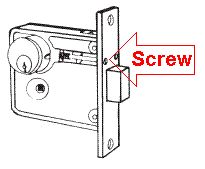
Key Stuck in Lock
The solution will require a small screwdriver.

On
the edge of the door you may see a small hole with a screw inside it.
Turn it CCW to loosen it, but if it doesn't get immediately easier to
turn, turn it CW instead. Some older
models of Corbin brand locks required a CW turn to loosen.
Once that has been loosened around 3-4 turns you should be able to turn
the cylinder itself CCW to screw it out of the door.
The key should be turned toward the position it normally can be withdrawn
while doing this.
There
are usually two screws on the back of the cylinder that have come loose.
Simply tighten them, but not so tight that the key is hard to turn, and
then the key should come out easily. Once
you have tightened the screws it is possible to peen them into place to help
prevent them from loosening again. Take
any pointed metal like a center punch that can be hit with a hammer, place the
point at the edge of each screw and tap the tool once to create a dimple where
the screw meets the retainer plate. That
will stop the screw from loosening itself but it will still be possible to
unscrew it when you need to for rekeying.
If
your lock cylinder has a C clip instead of screws, you can bend the clip
slightly and then reinstall it. The
key should then insert or withdraw more freely. Just be sure that you
don't try to pull the key out while the clip is off of the cylinder or you will
need a professional to reassemble it.
To
put the mortise cylinder back in the door, screw it in CW until flush with the
door, but be careful not to cross thread it. The threads are a fine grade and easily damaged. The last
turn of the cylinder may require a little more force and you can insert the key
PARTIALLY to use it as leverage. Be careful that you don't break it off in
the lock because removal will usually require a professional technique.
Copyright © 2012, Thelockman LLC. ALL rights reserved